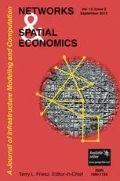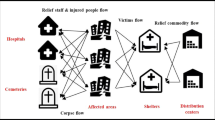Abstract
In this study, a two-stage stochastic integer programming model is developed with a centralized planning perspective to simultaneously address mitigation and response decisions in humanitarian logistics, where the mitigation decisions involve both building and transportation infrastructure retrofitting. The objective is to minimize the total cost of retrofitting, relief item transportation and relief item shortage under a limited mitigation budget. Due to the excessive number of binary decision variables, solving the model becomes computationally difficult. Therefore, we propose Lagrangean relaxation to decouple the overall model and solve it by Lagrangean heuristics. Computational results indicate the efficiency of the solution approaches in providing high quality feasible solutions to problem instances of realistic size and complexity.






Similar content being viewed by others
References
Anaya-Arenas AM, Renaud J, Ruiz A (2014) Relief distribution networks: a systematic review. Ann Oper Res 223(1):53–79
Bana e Costa C, Oliveira C, Vieira V (2008) Prioritization of bridges and tunnels in earthquake risk mitigation using multicriteria decision analysis: application to Lisbon. Omega 36(3):442–450
Chen A, Yang H, Lo H, Tang W (2002) Capacity reliability of a road network: an assessment methodology and numerical results. Transp Res B Methodol 36(3):225–252
Chen A, Yang C, Kongsomsaksakul S, Lee M (2007) Network-based accessibility measures for vulnerability analysis of degradable transportation networks. Networks and Spatial Economics 7(3):241–256
Dantzig G (1957) Discrete-variable extremum problems. Oper Res 5(2):266–288
Dodo A, Davidson R, Xu N, Nozick L (2007) Application of regional earthquake mitigation optimization. Comput Oper Res 34(8):2478–2494
Döyen A, Aras N, Barbarosoğlu G (2012) A two-echelon stochastic facility location model for humanitarian relief logistics. Optim Lett 6(6):1123–1145
Du L, Peeta S (2014) A stochastic optimization model to reduce expected post-disaster response time through pre-disaster investment decisions. Networks and Spatial Economics 14(2):271–295
Fan Y, Liu C (2008) Solving stochastic transportation network protection problems using the progressive hedging-based method. Networks and Spatial Economics 10(2):193–208
Faturechi R, Miller-Hooks E (2014) Measuring the performance of transportation infrastructure systems in disasters: a comprehensive review. Journal of Infrastructure Systems 21(1):04014025
Grass E, Fischer k. (2016) Two-stage stochastic programming in disaster management: a literature survey. Surveys in Operations Research and Management Science 21(2):85–100
Günneç D, Salman F (2007) A two stage multi-criteria stochastic programming model for location of emergency response and distribution centers. In: Euro winter institute on location and logistics, Estoril, Portugal, vol 35, pp 209-227
Günneç D, Salman F (2011) Assessing the reliability and the expected performance of a network under disaster risk. OR Spectrum 33(3):499–523
Habib MS, Lee YH, Memon MS (2016) Mathematical models in humanitarian supply chain management: a systematic literature review. Math Probl Eng 2016 (Article ID 3212095):20
Haneveld W, Van Der Vlerk M (2001) Optimizing electricity distribution using two-stage integer recourse models. Appl Opt 54:137–154
Held M, Wolfe P, Crowder H (1974) Validation of subgradient optimization. Math Program 6(1):62–88
Hoyos MC, Morales RS, Akhavan-Tabatabaei R (2015) OR Models with stochastic components in disaster operations management: a literature survey. Comput Ind Eng 82:183–197
JICA-IMM (2002) The study on a disaster prevention/mitigation basic plan in Istanbul including microzonation in the Republic of Turkey. Tech. rep., Japanese International Cooperation Agency, Local Municipality of Istanbul, Final report, vol V, Sept 2002
Karaman H, Şahin M, Elnashai A, Pineda O (2008) Loss assessment study for the Zeytinburnu district of Istanbul using Maeviz-Istanbul (HAZTURK). J Earthq Eng 12(S2):187–198
Liu C, Fan Y, Ordóñez F (2009) A two-stage stochastic programming model for transportation network protection. Comput Oper Res 36(5):1582–1590
Mete H, Zabinsky Z (2010) Stochastic optimization of medical supply location and distribution in disaster management. Int J Prod Econ 126(1):76–84
Miller-Hooks E, Zhang X, Faturechi R (2012) Measuring and maximizing resilience of freight transportation networks. Comput Oper Res 39(7):1633–1643
Peeta S, Salman F, Gunnec D, Viswanath K (2010) Pre-disaster investment decisions for strengthening a highway network. Comput Oper Res 37(10):1708–1719
Phaup M, Kirschner C (2010) Budgeting for disasters: focusing on the good times. OECD J Budg 2010:1
Rawls C, Turnquist M (2010) Pre-positioning of emergency supplies for disaster response. Transp Res B 44(4):521–534
Salmerón J, Apte A (2010) Stochastic optimization for natural disaster asset prepositioning. Prod Oper Manag 19(5):561–574
Sanchez-Silva M, Daniels M, Lleras G, Patiño D (2005) A transport network reliability model for the efficient assignment of resources. Transp Res B Methodol 39 (1):47–63
Sohn J (2006) Evaluating the significance of highway network links under the flood damage: an accessibility approach. Transp Res A Policy Pract 40(6):491–506
Taylor MAP, Sekhar SVC, DEste GM (2006) Application of accessibility based methods for vulnerability analysis of strategic road networks. Networks and Spatial Economics 6(3–4):267–291
Tufekci S, Wallace W (1998) Emerging area of emergency management and engineering. IEEE Trans Eng Manag 45(2):103–105
Vaziri P, Davidson R, Nozick L, Hosseini M (2010) Resource allocation for regional earthquake risk mitigation: a case study of Tehran, Iran. Nat Hazards 53(3):527–546
Viswanath K, Peeta S (2003) Multicommodity maximal covering network design problem for planning critical routes for earthquake response. Transp Res Rec J Transp Res Board 1857:1–10
Xu N, Davidson R, Nozick L, Dodo A (2007) The risk-return tradeoff in optimizing regional earthquake mitigation investment. Struct Infrastruct Eng Maint Manag Life-Cycle 3(2):133–146
Yushimito W, Jaller M, Ukkusuri S (2012) A Voronoi-Based heuristic algorithm for locating distribution centers in disasters. Networks and Spatial Economics 12(1):21–39
Yücel E., Salman FS, Arsik I (2018) Improving post-disaster road network accessibility by strengthening links against failures. Eur J Oper Res 269(2):406–422
Zolfaghari MR, Peyghaleh E (2015) Implementation of equity in resource allocation for regional earthquake risk mitigation using two-stage stochastic programming. Risk Anal 35(3):434–458
Author information
Authors and Affiliations
Corresponding author
Additional information
Publisher’s Note
Springer Nature remains neutral with regard to jurisdictional claims in published maps and institutional affiliations.
Rights and permissions
About this article
Cite this article
Döyen, A., Aras, N. An Integrated Disaster Preparedness Model for Retrofitting and Relief Item Transportation. Netw Spat Econ 19, 1031–1068 (2019). https://doi.org/10.1007/s11067-019-9441-6
Published:
Issue Date:
DOI: https://doi.org/10.1007/s11067-019-9441-6




